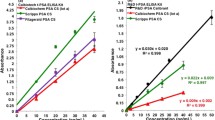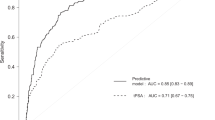Abstract
Recent studies have shown that there are systematic differences among total and free prostate-specificantigen (PSA) immunoassays. In this study we analyzedintermethod differences in total PSA (tPSA) and free PSA(fPSA) measurement using ARCHITECT i2000SR (Abbott Diagnostics) and COBAS E601 (Roche Diagnostics). A number of 160 blood samples were tested for tPSA and 50 samples for fPSA (selecting only sampleswith tPSA: 4.1–10.0 μg/L). Passing–Bablok regression analysis was used to compare the two analytical methods fortPSA, fPSA and percentage of fPSA (%fPSA). A strong correlation was noticed between ARCHITECT i2000SR and COBAS E601 for tPSA, fPSA and %fPSA (r between 0.94 and 0.99). Concentrations of tPSA and fPSA measured by COBAS E601 were higher thanthose measured by ARCHITECT i2000SR with a bias of 0.8 μg/L for tPSA and 0.14 μg/L for fPSA. Analyzing therelative difference between methods for fPSA and %fPSA, COBAS E601 exceed a 10% relative difference limit. Our study confirms that there are differences in measured concentrations of tPSA and fPSA byvarious commercial methods. Because clinical judgment on subsequent diagnostic procedures, such as prostatebiopsy, is based on tPSA and fPSA results, tests harmonization should be a priority.



Similar content being viewed by others

References
Chistiakov DA, Myasoedova VA, Grechko AV, Melnichenko AA, Orekhov AN. New biomarkers for diagnosis and prognosis of localized prostate cancer. Semin Cancer Biol. 2018;52(Pt 1):9–16. pii: S1044-579X(17)30288. https://doi.org/10.1016/j.semcancer.2018.01.012.
Ayyıldız SN, Ayyıldız A. TSA, PSA derivatives, proPSA and prostate health index in the diagnosis of prostate cancer. Turk J Urol. 2014;40(2):82–8. https://doi.org/10.5152/tud.2014.94547.
Stenman UH, Leinonen J, Alfthan H, Ranniko S, Tuhkanen K, Alfthan O. A complex between prostate specific antigen and alpha-antichymotrypsin is the major form of prostate specific antigen in serum of patients with prostate cancer: assay of the complex improves clinical sensitivity for cancer. Cancer Res. 1991;51(1):222–6.
Lilja H, Christensson A, Dahlén U, Matikainen MT, Nilsson O, Pettersson K, et al. Prostate-specific antigen in serum occurs predominantly in complex with alpha 1-antichymotrypsin. Clin Chem. 1991;37(9):1618–25.
Wang Q, Li YF, Jiang J, Zhang Y, Liu XD, Li K. The establishment and evaluation of a new model for the prediction of prostate cancer. Medicine (Baltimore). 2017;96(11):e6138. https://doi.org/10.1097/MD.0000000000006138.
Loeb S. Time to replace prostate-specific antigen (PSA) with the prostate health index (PHI)? Yet more evidence that the PHI consistently outperforms PSA across diverse populations. BJU Int. 2015;115:500. https://doi.org/10.1111/bju.12966.
Catalona WJ, Partin AW, Slawin KM, Brawer MK, Flanigan RC, Patel A, et al. Use of the percentage of free prostate-specific antigen to enhance differentiation of prostate cancer from benign prostatic disease; a prospective multicenter clinical trial. JAMA. 1998;279(19):1542–7. https://doi.org/10.1001/jama.279.19.1542.
De Keukeleire S, Wauters A, Luyts D, Chandler C, Piqueur M. Analytical performance of the VITROS immunodiagnostic products total PSA II and free PSA assays. Clin Biochem. 2014;47(13–14):1323–5. https://doi.org/10.1016/j.clinbiochem.2014.06.006Epub 2014.
Hugosson J, Carlsson S, Aus G, Bergdahl S, Khatami A, Lodding P, et al. Mortality results from the Goteborg randomised population-based prostate-cancer screening trial. Lancet Oncol. 2010;11:725–32. https://doi.org/10.1016/S1470-2045(10)70146-7Epub 2010.
Holmstrom B, Johansson M, Bergh A, Stenman UH, Hallmans G, Stattin P. Prostate specific antigen for early detection of prostate cancer: longitudinal study. BMJ. 2009;339:b3537. https://doi.org/10.1136/bmj.b3537.
Catalona WJ, Smith DS, Ornstein DK. Prostate cancer detection in men with serum PSA concentrations of 2.6 to 4.0 ng/mL and benign prostate examination. Enhancement of specificity with free PSA measurements. JAMA. 1997;277:1452–5. https://doi.org/10.1001/jama.1997.03540420048028.
Semjonow A, Oberpenning F, Weining C, Schön M, Brandt B, De Angelis G, et al. Do modifications of nonequimolar assays for total prostate-specific antigen improve detection of prostate cancer? Clin Chem. 2001;47:1472–5.
Mikolajczyk SD, Song Y, Wong JR, Matson RS, Rittenhouse HG. Are multiple markers the future of prostate cancer diagnostics? Clin Biochem. 2004;37:519–28. https://doi.org/10.1016/j.cca.2007.02.017.
Sturgeon CM, Ellis AR. Improving the comparability of immunoassays for prostate-specific antigen (PSA), progress and problems. Clin Chem Acta. 2007;381:85–92. https://doi.org/10.1016/j.cca.2007.02.015.
Sturgeon CM, Seth J. Why do immunoassays for tumor markers give differing results? A view from the UK national external quality assessment schemes. Eur J Clin Chem Clin Biochem. 1996;34:755–9.
Koziorowski J, Stanciu AE, Gomez-Vallejo V, Llop J. Radiolabeled nanoparticles for cancer diagnosis and therapy. Anticancer Agents Med Chem. 2017;17(3):333–54. https://doi.org/10.2174/1871520616666160219162902.
Serdarevic N, Serdarevic R, Memic A. Comparison of the performance of three cancer antigen (CA) 15-3 immunoassays. JHSCI 2016;6(3):154–61. https://www.jhsci.ba/OJS/index.php/jhsci/article/view/381.
Bishop ML, Fody EP, Schoeff LE. Clinical chemistry: techniques, principles, correlation. 6rd ed. Philadelphia: Wolters Kluwer Health; 2010. Available from: www.academia.edu/29483806/Clinical_Chemistry_Techniques_Principles_Correlations.
Roddam AW, Rimmer J, Nickerson C, Ward AM; NHS Prostate Cancer Risk Management Programme. Prostate-specific antigen: bias and molarity of commercial assays for PSA in use in England. Ann Clin Biochem. 2006;43(Pt 1):35–48. https://doi.org/10.1258/000456306775141731.
Sturgeon CM, Duffy MJ, Stenman UH, Lilja H, Brunner N, Chan DW, et al. National Academy of Clinical Biochemistry laboratory medicine practice guidelines for use of tumor markers in testicular, prostate, colorectal, breast, and ovarian cancers. Clin Chem. 2008;54(12):e11–79. https://doi.org/10.1373/clinchem.2008.105601.
Filella X, Alcover J, Molina R, Luque P, Corral JM, Augé JM, et al. Usefulness of proprostate-specific antigen in the diagnosis of prostate cancer. Anticancer Res. 2007;27(1B):607–10.
Bilić-Zulle L. Comparison of methods: passing and Bablok regression. Biochem Med (Zagreb). 2011;21(1):49–52.
Gray MA, Cooke RR, Weinstein P, Nacey JN. Comparability of serum prostate-specific antigen measurement between the Roche Diagnostic Elecsys 2010 and the Abbott Architect I 2000. Ann Clin Biochem. 2004;41(Pt 3):207–12. https://doi.org/10.1258/000456304323019578.
Jung K, Meyer A, Lein M, Rudolph B, Schnorr D, Loening SA. Ratio of free-to-total prostate specific antigen in serum can not distinguish patients with prostate cancer from those with chronic inflammation of the prostate. J Urol. 1998;159(5):1595–8.
Kort S, Martens F, Vanpoucke H, van Duijnhoven HL, Blankenstein MA. Comparison of 6 automated assays for total and free prostate-specific antigen with special reference to their reactivity toward the WHO 96/670 reference preparation. Clin Chem. 2006;52:1568–74. https://doi.org/10.1373/clinchem.2006.069039.
Rutledge AC, Pond GR, Hotte SJ, Kavsak PA. Assessing the necessity of including a crossover period with dual reporting when changing total prostate-specific antigen methods. Clin Biochem. 2014;47:897–900. https://doi.org/10.1016/j.clinbiochem.2014.03.027Epub 2014.
Blijenberg BG, Yurdakul G, Van Zelst BD, Bangma CH, Wildhagen MF, Schröder FH. Discordant performance of assays for free and total prostate-specific antigen in relation to the early detection of prostate cancer. BJU Int. 2001;88:545–50. https://doi.org/10.1046/j.1464-410X.2001.02374.x.
Stephan C, Klaas M, Muller C, Schnorr D, Loening SA, Jung K. Interchangeability of measurements of total and free prostate-specific antigen in serum with 5 frequently used assay combinations: an update. Clin Chem. 2006;52(1):59–64. https://doi.org/10.1373/clinchem.2005.059170Published 2006.
Author information
Authors and Affiliations
Corresponding author
Ethics declarations
Conflict of interest
The authors declare that they have no conflict of interest.
Additional information
Publisher's Note
Springer Nature remains neutral with regard to jurisdictional claims in published maps and institutional affiliations.
Rights and permissions
About this article
Cite this article
Serdarevic, N., Dabla, P. & Stanciu, A.E. Systematic Differences Between Total and Free Prostate-Specific Antigen Immunoassays: Comparison Using Passing and Bablok Regression. Ind J Clin Biochem 36, 151–158 (2021). https://doi.org/10.1007/s12291-019-0818-6
Received:
Accepted:
Published:
Issue Date:
DOI: https://doi.org/10.1007/s12291-019-0818-6



